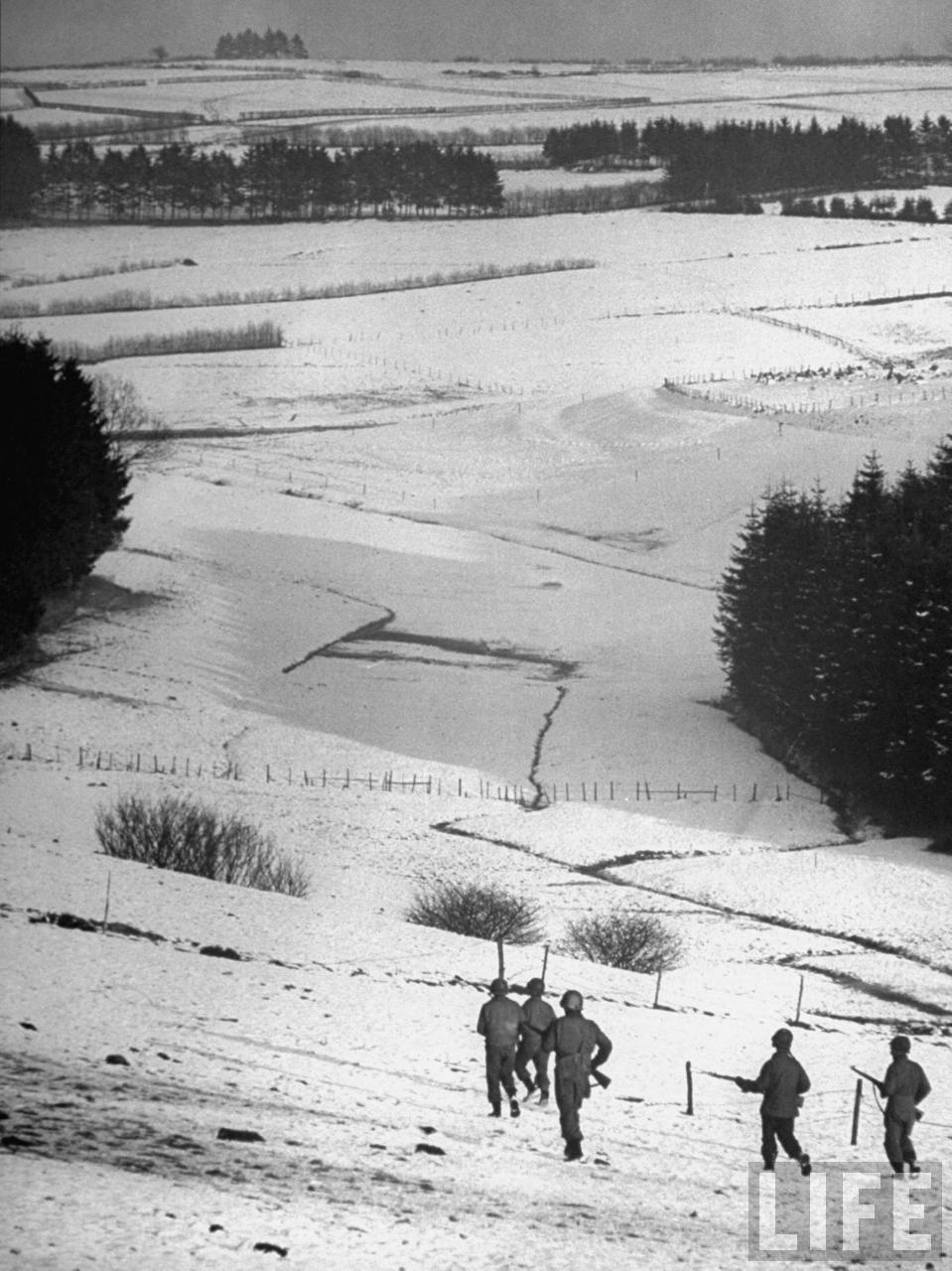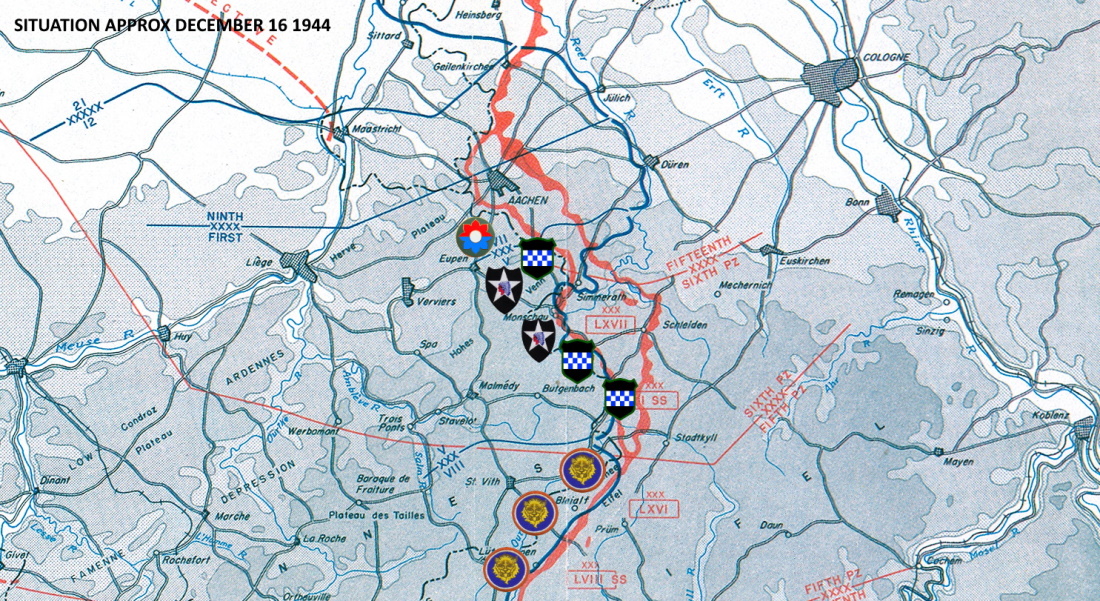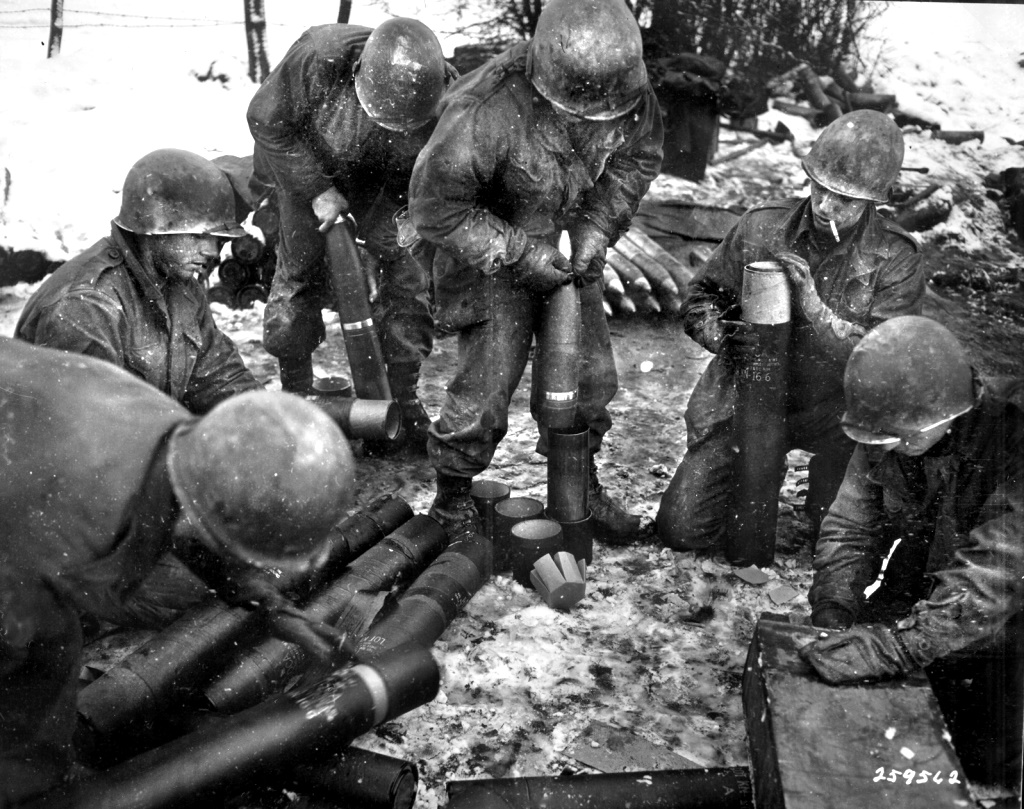Document Source: Operations of the 1st Battalion, 422nd Infantry Regiment, 106th Infantry Division (Golden Lion), Vicinity of Schlausenbach, Germany, December 10-19, 1944, Personal Experience of a battalion Executive Officer, Maj William P. Moon Jr
INTRODUCTION

 During the period September 1944 to December 1944, many changes in the disposition of the troops along the front were made in preparation for continuing the advance to the east.
During the period September 1944 to December 1944, many changes in the disposition of the troops along the front were made in preparation for continuing the advance to the east.
By Dec 9, the VIII Corps of the 1-A had taken over the  positions of the V Corps along the Schnee Eifel with the mission of conducting an aggressive defense and be prepared to advance on Koln on order. This was a sector extending from Monschau, on the extreme north, to a point where the Moselle River crosses the Franco-German Boundary at the northeast corner of Luxembourg. This sector comprised a front of approximately 100 miles.
positions of the V Corps along the Schnee Eifel with the mission of conducting an aggressive defense and be prepared to advance on Koln on order. This was a sector extending from Monschau, on the extreme north, to a point where the Moselle River crosses the Franco-German Boundary at the northeast corner of Luxembourg. This sector comprised a front of approximately 100 miles.

 Since there had been very little enemy activity, either than minor patrols, and it was known that the Germans were using this sector for indoctrinating green troops to the sounds of battle, it was dubbed the quiet sector.
Since there had been very little enemy activity, either than minor patrols, and it was known that the Germans were using this sector for indoctrinating green troops to the sounds of battle, it was dubbed the quiet sector.

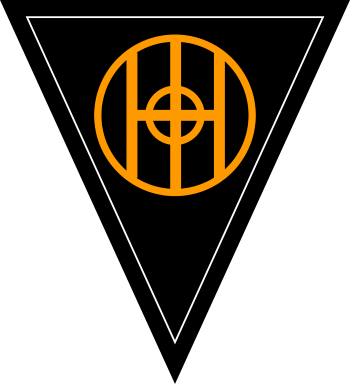 This sector was defended by a task force and three infantry divisions abreast. The 2-ID on the north occupied a salient in the Siegfried Line along the high wooded Schnee Eifel Ridge. Task Force X was attached to the 2-ID and occupied a five miles front north of the Schnee Eifel positions and maintained contact with the 99-ID (V Corps) on its left. The 28-ID defended the center section along the Our River on the right of the 2-ID and the 83-ID defended the southern part of the sector along the Our River to its confluence with the Moselle River and thence up the Moselle to the boundary between the VIII and the XX Corps of the 3-A.
This sector was defended by a task force and three infantry divisions abreast. The 2-ID on the north occupied a salient in the Siegfried Line along the high wooded Schnee Eifel Ridge. Task Force X was attached to the 2-ID and occupied a five miles front north of the Schnee Eifel positions and maintained contact with the 99-ID (V Corps) on its left. The 28-ID defended the center section along the Our River on the right of the 2-ID and the 83-ID defended the southern part of the sector along the Our River to its confluence with the Moselle River and thence up the Moselle to the boundary between the VIII and the XX Corps of the 3-A.

The 9th Armored Division which had no combat experience was placed in Corps reserve and used this period to rotate its infantry units in the division front lines to gain a little more combat experience.
GENERAL SITUATION

 The 106th Infantry Division landed at Le Havre, France on Dec 6, 1944, and moved by a succession of motor marches across France and Belgium. On Dec 8-10, the division closed in an assembly area in the snow-covered Ardennes Forest in the 2-ID sector near St Vith. The division was assigned to the VIII Corps and was to be given an opportunity to gain combat experience by occupying defensive positions in the relatively quiet sector of the VIII Corps, partly in
The 106th Infantry Division landed at Le Havre, France on Dec 6, 1944, and moved by a succession of motor marches across France and Belgium. On Dec 8-10, the division closed in an assembly area in the snow-covered Ardennes Forest in the 2-ID sector near St Vith. The division was assigned to the VIII Corps and was to be given an opportunity to gain combat experience by occupying defensive positions in the relatively quiet sector of the VIII Corps, partly in  Germany and partly in Belgium. The 106-ID was to relieve the veteran 2-ID, attached to Task Force X and in one defensive position in the northern sector of the VIII Corps along the Schnee Eifel Ridge. The 2-ID was being attached to the V Corps in preparation for an attack in the area of the Roer River Dams.
Germany and partly in Belgium. The 106-ID was to relieve the veteran 2-ID, attached to Task Force X and in one defensive position in the northern sector of the VIII Corps along the Schnee Eifel Ridge. The 2-ID was being attached to the V Corps in preparation for an attack in the area of the Roer River Dams.
Attached to the 106th Infantry Division (Gen Allan Jones) were the 18th Cavalry Recon Squadron and the 32nd Cavalry Recon Squadron, both from the 14th Cavalry Group. These squadrons were to take over the sector occupied by Task Force X now attached to the 2-ID and maintain contact between the 106-ID, now located in the south of the northern shoulder, and the 99-ID occupying the northern frontline of the northern shoulder. The disposition of troops for the 106-ID was to be elements of the 14-CG, the 422-IR in the north, the 423-IR in the center, and the 424-IR, less one battalion, in the south. One battalion of the 424-IR was to be in the division reserve.
The enemy, as known to the Division CG at this time, consisted of elements of the partly trained 18.VGD and the 26.VGD and their supporting artillery. Two panzer divisions were also reported to be somewhere in reserve. It was believed that these panzer divisions were held in reserve in case of an attack by the VIII Corps. The combat efficiency of the German troops in comparison with the 106-ID was estimated as generally the same since the 106-ID had no combat experience and a definite pattern had shown that for the past month the comparatively quiet sector in front of the VIII Corps had been used by the Germans for seasoning newly formed divisions. This particular area of the Schnee Eifel is a hogback ridge, characterized by high plateaus, deeply enclosed valleys, and a restricted road net. This area is heavily wooded with steep ravines and ridges running to the east and west. The road net consisted of narrow dirt roads in poor condition running generally north and south along the ridge. Due to the snow and ice at this time some of the roads were almost impassable. The fortifications of the Siegfried Line ran generally along the crest of the Schnee Eifel. These fortifications consisted of concrete pillboxes, dug-in gun positions, and foxholes. The weather was cold, the ground was covered with snow and ice, and snow fell intermittently. The sky was cloudy and dull and a heavy mist hung about the tops of the trees. The supply situation throughout the Corps was normal except for a shortage of Prestone tires, PX rations, miscellaneous signal equipment, shoes, overshoes, and raincoats.
DISPOSITION – PLAN 422-IR
On Dec 9, the 422-IR closed in its assembly area in the Ardennes Forest in the vicinity of St Vith. On order from Hqs 106-ID, the 422-IR and its supporting 589-FAB (105-MM HOW) would relieve the 9-IR and its 15-FAB (105-MM HOW). This order stated that the 422-IR was to take over from the 9-IR, man for man and gun for gun, on or about Dec 11 and continue the defense. The 422’s plan for the relief was as follows: the 2/422 would relieve the 2/9, on the north, the 1/422 would relieve the 2/23, which had relieved the 1/9 on Dec 4 so it could go to a rest area at Steinebruck in the center. The 3/422 would relieve the 3/9 on the south. The regiment would move by motor from its present position at 0900 Dec 10 to execute the relief. The battalions would move in the following order 2/422, 1/422, and 3/422.
Well after dark on Dec 9, after another all-day motor march in open trucks, freezing weather, and in a blinding snowstorm, the 1/422 closed in its assembly area in the Ardennes Forest in the vicinity of St Vith. The Battalion was met by guides from the quartering party, the Battalion Commander, and the Company Commander. The Battalion Commander, his party, and Company Commanders had gone forward earlier in the day to have their first look at the positions they were to take over the following day. The blinding snow, that was falling, and the restriction on the use of lights made it very difficult for the men to follow their guides. Some of them were separated from their units and found their way to other company areas. It was the next morning before the companies could reassemble. The battalion kitchens, which had been under regimental control since the march began, had arrived a few hours earlier and had hot coffee waiting for the men. This was indeed a treat and a morale booster. Even though the morale of the troops was high, the fatigue of the long motor marches across France in open trucks in rain and snow, the lack of hot meals, and no opportunity to change to dry clothes tended to lower the combat efficiency of the unit as a whole. At this time, the battalion was approximately up to TO&E strength. The Battalion Commander’s orders were to relieve the 1/23-IR, then attached to the 9-IR, man for man, gun for gun. The kitchens were to move up in the vicinity of the Company’s CP and the men’s duffel bags would be up later.
DISPOSITION – PLAN OF THE 1/422-IR
The Battalion CO oriented his staff as to the situation. The enemy forces opposing the positions were not positively identified at this time but, it was a quiet sector and the activity was limited to light patrolling. The battalion was to take over positions on the eastern slope of the Schnee Eifel. This slope was steep and heavily wooded. The few available roads were in poor condition, covered with snow and mud. Positions consisting of foxholes and squad shelters, most of them full of mud or water, had been prepared previously by other units. There were minefields and barbed wire entanglements out to the front. Trip flares and antipersonnel mines were scattered along the front in the gaps between occupied positions.
The Battalion CO’s plan for the relief of the 1/23-IR was a company for a company; Charlie on the left, Baker in the center, and Able on the right. Baker would take over the positions of Dog Company (1/23) and Battalion Hqs Co would relieve Battalion Hqs Co (1/23), installation for installation. The Company COs had received their orders for the relief while on recon with the Battalion CO earlier in the day. The battalion was to be ready to move by trucks at 0900 Dec 10.
NARRATION – THE RELIEF
Early in the cold gray dawn of December 10, the 1/422, still wet, cold, and tired from its motor march across France and Belgium, dug itself out of the snow in its bivouac area in the vicinity of St Vith. After a skimpy hot breakfast, companies were formed and began preparations for the move to the front lines. Men and equipment were checked, the men counted off and truck numbers were assigned. Approximately fifteen or twenty men had to be evacuated to the rear because of trench foot. This was caused by the lack of dry socks and overshoes. Last-minute police of the area was made and the companies formed. The battalion was formed in the woods, ready to move, but as often happens in motor moves, the trucks had not arrived. After waiting approximately two hours, stomping around in the snow to keep warm, the trucks arrived. The battalion was loaded and the movement to the front began.
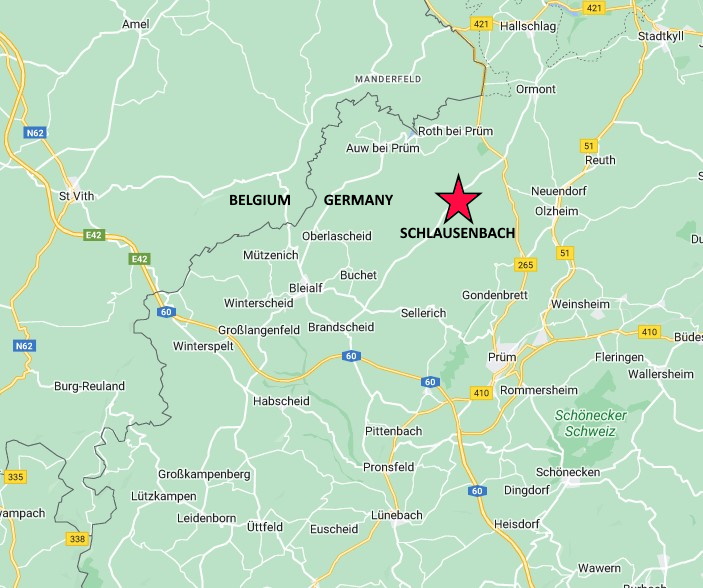 The road was rough and covered with ice, snow, and mud. This slowed down the movement of the column and it was late in the afternoon before it finally stopped in the vicinity of the CP of the 1/23 (2-ID). This command post was located on the western slope of the Schnee Eifel in a German pillbox of the Siegfried Line at a crossroad about 3000 yards east of Schlausenbach, Germany, and about a mile from the front line positions which were located on the eastern slope of the ridge. The battalion was met by the CO of the 1/23-IR, his staff, and one officer from each of his companies. The battalion detrucked and its units marched the last mile to their front line positions, guided by one officer per company and one non-com officer per platoon left by the 1/23. Some of the men of the 23-IR were already formed, waiting to load on the trucks that brought the 1/422 up and start their movement to the rear. Several remarks were made by these men as to how lucky we were to be moving into this quiet sector. It was better than a rest camp, according to them, there was no close-order drill up here.
The road was rough and covered with ice, snow, and mud. This slowed down the movement of the column and it was late in the afternoon before it finally stopped in the vicinity of the CP of the 1/23 (2-ID). This command post was located on the western slope of the Schnee Eifel in a German pillbox of the Siegfried Line at a crossroad about 3000 yards east of Schlausenbach, Germany, and about a mile from the front line positions which were located on the eastern slope of the ridge. The battalion was met by the CO of the 1/23-IR, his staff, and one officer from each of his companies. The battalion detrucked and its units marched the last mile to their front line positions, guided by one officer per company and one non-com officer per platoon left by the 1/23. Some of the men of the 23-IR were already formed, waiting to load on the trucks that brought the 1/422 up and start their movement to the rear. Several remarks were made by these men as to how lucky we were to be moving into this quiet sector. It was better than a rest camp, according to them, there was no close-order drill up here.

The relief was made without incident and it was well after dark when the last positions were finally taken over. It was to be another cold sleepless night for most of the battalion. The kitchens were brought forward and set up several hundred yards behind the front line positions in the vicinity of the Company CP. A meal was prepared, mostly hot coffee and cold sandwiches, and the feeding began. The men ate in shifts, a few from each squad sector at a time. It was well toward midnight when the feeding was completed. In spite of the fact that the men had been told that this was a quiet sector and that they had nothing to worry about, most of them were a little nervous and jittery. This could be expected since it was their first time in battle positions and they had only been on the Continent for five days. The night passed without any activity from the enemy, but, one of Able Co’s Officers and a guide that was left to show the men their positions were shot and slightly wounded by one of Able Co’s outposts while they were checking positions. As stated before, the men were a little jittery. Schedules of patrols, overlays of their routes, the front line positions, and final protective fires were turned over and explained to the unit commanders by the officers left behind by the 23-IR (2-ID). All information concerning enemy positions, activity, and that pertinent to the friendly positions, patrols, and terrain was turned over to the respective unit commanders. At about 2045 December 10, the relief was finally completed gun for gun, and man for man. The companies were disposed of as follows: Charlie, northern sector; Baker, center sector; Able, southern sector, and Dog, in general support













